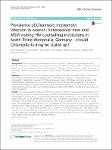Prevalence of Chlamydia trachomatis infection in women, heterosexual men and MSM visiting HIV counselling institutions in North Rhine-Westphalia, Germany - should Chlamydia testing be scaled up?
Lallemand, Anne
Bremer, Viviane
Jansen, Klaus
Nielsen, Stine
Münstermann, Dieter
Lucht, Andreas
Tiemann, Carsten
Background: Patients asking for a free anonymous HIV test may have contracted other sexually transmitted infections (STIs) such as Chlamydia trachomatis, yet Chlamydia prevalence in that population is unknown. This study aimed to assess the prevalence and factors associated with Chlamydia infection in patients seeking HIV testing at local public health authorities (LPHA) in order to evaluate whether Chlamydia testing should be routinely offered to them. Methods: We conducted a cross-sectional study among patients (≥18 years) attending 18 LPHA in North Rhine-Westphalia from November 2012 to September 2013. LPHA collected information on participants’ socio-demographic characteristics, sexual and HIV testing behaviours, previous STI history and clinical symptoms. Self-collected vaginal swabs and urine (men) were analysed by Transcription-Mediated Amplification. We assessed overall and age-stratified Chlamydia prevalence and 95 % confidence intervals (95 % CI). Using univariate and multivariable binomial regression, we estimated adjusted prevalence ratios (aPR) to identify factors associated with Chlamydia infection. Results: The study population comprised 1144 (40.5 %) women, 1134 (40.1 %) heterosexual men and 549 (19.4 %) men who have sex with men (MSM); median age was 30 years. Chlamydia prevalence was 5.3 % (95 % CI: 4.1–6.8 %) among women, 3.2 % (95 % CI: 2.2–4.4) in heterosexual men and 3.5 % (95 % CI: 2.1–5.4) in MSM. Prevalence was highest among 18–24 year-old women (9 %; 95 % CI: 5.8–13) and heterosexual men (5.7 %; 95 % CI: 3.0–9.8 %), respectively. Among MSM, the prevalence was highest among 30–39 year-olds (4.4 %; 95 % CI: 1.9–8.5 %). Among those who tested positive, 76.7 % of women, 75.0 % of heterosexual men and 84.2 % of MSM were asymptomatic. Among women, factors associated with Chlamydia infection were young age (18–24 years versus ≥ 40 years, aPR: 3.0, 95 % CI: 1.2–7.8), having had more than 2 partners over the past 6 months (ref.: one partner, aPR: 2.1, 95 % CI: 1.1–4.0) and being born abroad (aPR: 1.9, 95 % CI: 1.0–3.5). Among heterosexual men, young age was associated with Chlamydia infection (18–24 years versus ≥ 40 years, aPR: 4.1, 95 % CI: 1.3–13). Among MSM, none of the variables were associated with Chlamydia infection. Conclusions: LPHA offering HIV tests should consider offering routine Chlamydia testing to women under 30 years. Women with multiple partners and those born abroad may also be considered for routine testing. Our results also suggest offering routine Chlamydia testing to heterosexual men under 25 years old. For MSM, we cannot draw specific recommendations based on our study as we estimated the prevalence of urethral Chlamydia infection, leaving out rectal and pharyngeal infections.
Dateien zu dieser Publikation
Keine Lizenzangabe

